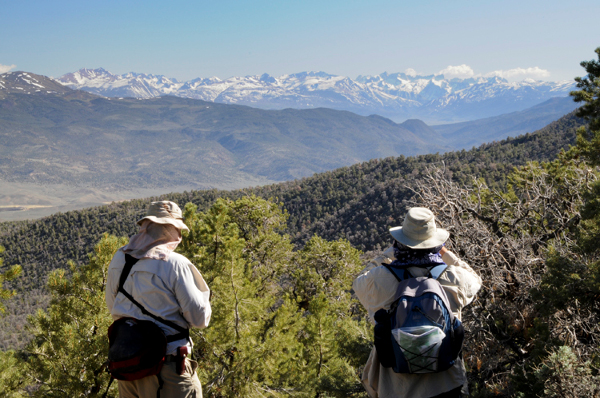
Looking across miles of pinyon-juniper forests, from the Wovoka Wilderness in western Nevada,
toward the Sierra Nevada in the distance. Credit: Brian Beffort
By Connie Howard, Conservation Chair, Toiyabe Chapter.
The Toiyabe Chapter of the Sierra Club is joining Defenders of Wildlife, the Southern Utah Wildlife Alliance, the National Resources Defense Council, The New Mexico Wilderness Alliance, WildEarth Guardians, The Wilderness Society and others in opposing four large-scale BLM Pinyon-Juniper Deforestation Projects. Of these, perhaps the most alarming is the Fuels Reduction and Rangeland Restoration in the Great Basin which covers nearly 223 million acres and includes portions of California, Idaho, Nevada, Oregon, Utah and Washington with the stated goal of minimizing the subsequent National Environmental Policy Act Work required to approve the on-the-ground projects.
These projects, proposed on a massive scale in the name of“restoration,” fuels breaks, and fuels reduction, would do immeasurable ecological harm on a scale hard to fathom. The Great Basin is deteriorating due to a variety of stressors and that site specific, science-based restoration efforts are needed. However, we believe these projects are not in the interests of the Great Basin landscape and wildlife. If completed as proposed, they would devastate sagebrush ecosystems throughout the region. These projects would also give the BLM carte blanche to conduct large-scale vegetation treatments without NEPA review, transparency, or public engagement.
Sierra magazing recently featured the story “Is Pinyon-Juniper Clearing Really the Answer to Sage Grouse Protection?" by Jeremy Miller. Miller explains that “for decades federal and state land-management agencies have painted a picture of juniper and pinyon pine as kudzu-like weeds devouring vast tracts of the West. In response to the alleged “invasion” and “encroachment” of juniper and pinyon pine, federal agencies have undertaken a vast deforestation campaign. Miller documents that between 1940 and 1964, more than 3 million acres of pinyon and juniper forests were cut down and converted to pasturelands. The BLM further reports that nearly 600,000 acres of coniferous forests were eliminated between 2009 and 2015.
Cut pinyon-juniper trees in the Virgnia Mountains north of Reno. Credit: Lori Bellis
Today, these deforestation “treatments” are done in the name of ecological stewardship. "Removing encroaching juniper will improve conditions for greater sage grouse and many other species that depend on a healthy sagebrush-steppe ecosystem," reads a 2018 BLM press release calling for the elimination of more than half a million acres of juniper forest in the remote Owyhee Mountains, straddling Idaho, Oregon, and Nevada.
This project is being advanced concurrently with the BLM’s Fuel Breaks in the Great Basin project. The project area, covering nearly 224 million acres, includes portions of California, Idaho, Nevada, Oregon, Utah, and Washington. The fuel breaks would be placed along a subset of available linear features, such as roads and rights-of-way on BLM-administered lands within sagebrush communities; these potential treatment areas cover approximately 38 million acres within the project area boundary. As with the Fuels Reduction project, Nevada is the most heavily impacted as almost 100% of the state falls in the project area.
There are many interrelated and serious environmental issues involved in the removal of pinyon and juniper forest, not the least of which are the carbon emissions that would be released if tens of thousands, if not hundreds of thousands, of acres of public forests were removed. In addition to vegetation removal and burning, there will be significant soil disturbances associated with these intrusive activities. Clearly, many millions of tons of carbon that are currently sequestered in these forests and soils could be released into the atmosphere, worsening climate change.
Sierra Club and our partners will submit comments before the June 2 deadline. Will keep you apprised as this process moves forward.
Please support your local Sierra Club in this important work.
This is just one of dozens of threats to public land and wildlife in Nevada and the Eastern Sierra.
Your support will help us stand strong against them
